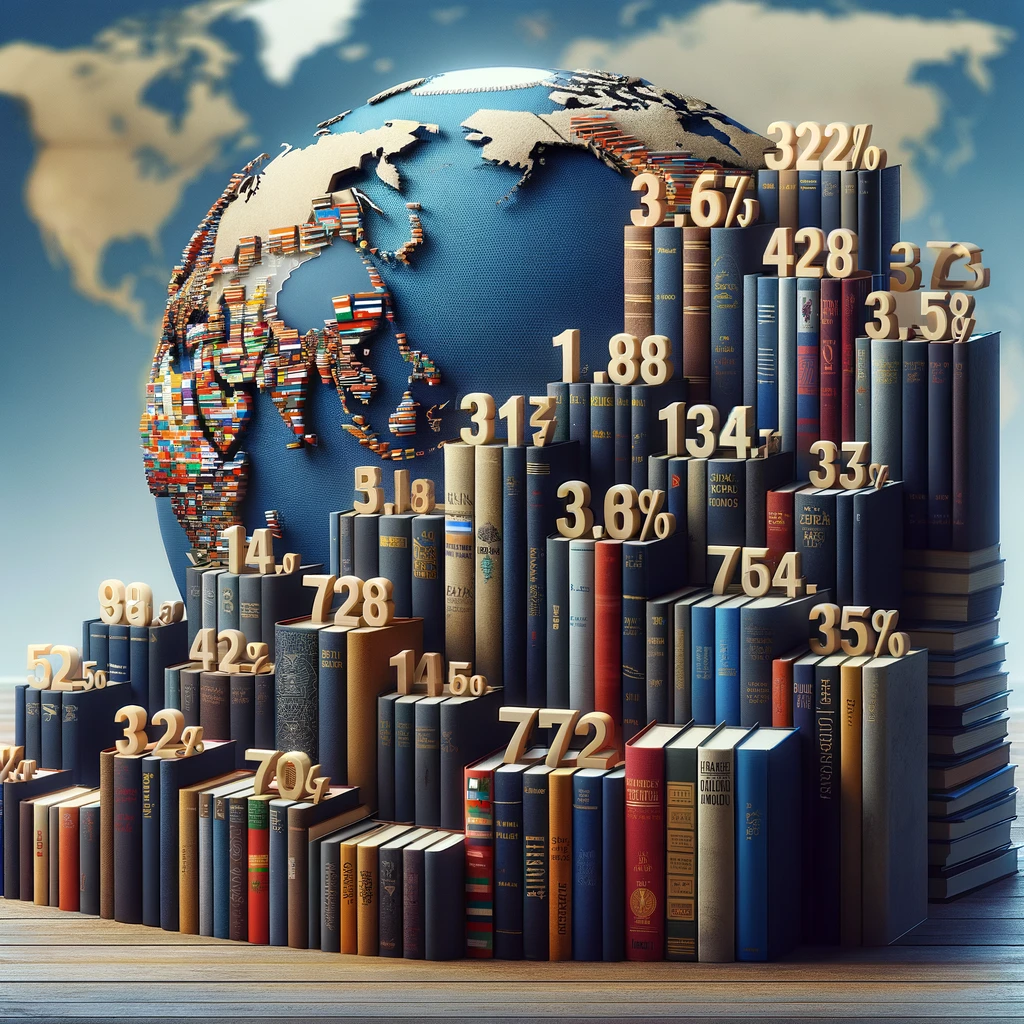
Literacy Rates Around the World: Great Progress and Challenges
Table of Contents

Literacy Rates
Literacy is the cornerstone of individual empowerment and societal progress. It unlocks a world of knowledge, fosters communication and critical thinking skills, and paves the way for personal and professional development. While significant strides have been made in improving literacy rates globally, substantial challenges remain. This article delves into the world of literacy, exploring the progress made, the obstacles faced, and the role it plays in creating a brighter future for all. We will analyze statistics, showcase successful initiatives, and highlight the crucial need for continued efforts towards achieving universal literacy.
Before diving into the Digital Textbook Revolution, be sure to check out the Learning Mole YouTube Channel! Here is a great video on Coding for kids!
Global Literacy Rates: A Story of Progress and Disparity
The global landscape of literacy presents a narrative of progress intertwined with persistent challenges. While we celebrate advancements and acknowledge the significant improvement in global adult literacy rates from 12% in 1820 to 86.3% in 2016, as reported by the World Bank, it’s crucial to delve deeper into the nuances of this story.
A Global Snapshot: Celebrating Milestones and Acknowledging Gaps
Positive strides have been made across the globe:
- Increased Access to Education: Expanded educational opportunities, particularly in developing regions, have contributed to a rise in literacy rates. This is particularly evident in countries like Vietnam, which achieved a remarkable 95.9% literacy rate in 2018, showcasing the impact of focused efforts.
- Demographic Shifts: As younger generations, who typically have higher literacy rates, become a larger proportion of the population, the global average literacy rate is projected to continue rising in the coming years.
- Technological Advancements: New technologies, such as mobile learning apps and audiobooks, have the potential to democratize access to learning materials and cater to diverse learning styles, potentially contributing to further progress.
However, significant disparities continue to exist:
- Regional Disparities: The global average masks major regional variations. Developed regions boast an average literacy rate of 99.2%, while the least developed countries face a much lower rate of 64.0%. This disparity highlights the need for targeted interventions and increased investment in regions struggling to bridge the literacy gap.
- Socio-economic Disparities: Within countries, there are often disparities in literacy rates based on socio-economic factors. Individuals from low-income backgrounds and marginalized communities often have lower literacy rates due to limited access to quality education.
- Rural-Urban Divide: Rural areas often have fewer educational resources and higher illiteracy rates compared to urban areas. Addressing this disparity requires tailored approaches that consider the specific challenges faced by rural communities.
Understanding the Significance of Literacy
Beyond its intrinsic value as a fundamental human right, literacy acts as a key driver of socio-economic development. It empowers individuals with the ability to:
- Access and understand information: Literacy allows individuals to access essential information about healthcare, employment, and their rights, facilitating informed decision-making and active participation in society.
- Communicate effectively: Literacy equips individuals with the ability to communicate effectively, fostering social interaction, collaboration, and participation in public life.
- Participate in the workforce: Literacy is essential for securing better job opportunities and actively contributing to the economy.
Looking Forward: Embracing a Multifaceted Approach
Achieving universal literacy requires a multifaceted approach that addresses the root causes of low literacy rates and leverages the potential of innovation:
- Investing in Quality Education: Ensuring access to equitable and quality education for all, particularly girls, is fundamental to achieving literacy goals. This includes providing adequate resources, qualified teachers, and learning environments conducive to literacy acquisition.
- Targeting Marginalized Groups: Specific interventions are needed to address the needs of marginalized communities and individuals facing barriers to education. This might involve using culturally relevant materials, providing alternative learning pathways, and addressing gender disparities.
- Harnessing Technology: Integrating technology strategically into education can cater to diverse learning styles, increase access to learning materials, and improve learning outcomes. However, ensuring equitable access to technology is crucial to avoid exacerbating existing disparities.
Progress in Literacy Rates: Shining a Light on Success
The journey towards universal literacy is not without its bright spots. Numerous successful literacy initiatives around the world serve as testaments to the power of collective action and innovative approaches. These stories offer valuable insights and inspire us to replicate their successes:
Case Studies in Success:
- Brazil’s “Luz do Saber” (Light of Knowledge): Launched in 2003, this program aimed to address high adult illiteracy rates through flexible learning methods and community engagement. It utilized volunteer educators, culturally relevant materials, and accessible learning centers, resulting in over 8 million adults acquiring basic literacy skills by 2007.
- India’s “Saakshar Bharat Mission” (Literate India Mission): Launched in 2017, this initiative focuses on female literacy and community mobilization. It empowers women through literacy training, vocational skills development, and leadership programs, contributing to a reduction in gender disparities in literacy rates.
- Ethiopia’s “Accelerated Learning Programme” (ALP): This program, established in 1994, targeted out-of-school youth and adults with a fast-track literacy curriculum, enabling them to acquire basic literacy skills within a short timeframe. It contributed to a significant increase in Ethiopia’s adult literacy rate, from 35% in 1994 to 83% in 2015.
Beyond individual programs, several broader trends contribute to progress:
- Increased International Collaboration: Organizations like UNESCO and the World Bank play a pivotal role in coordinating efforts, sharing best practices, and mobilizing resources to support national literacy initiatives.
- The Rise of NGOs and Civil Society: Non-governmental organizations (NGOs) and civil society groups play a crucial role in filling gaps in government-led initiatives. They often work at the grassroots level, tailoring programs to specific communities and addressing local needs.
- Technology-enabled Learning: The strategic use of technology, such as mobile learning apps and audiobooks, can increase access to learning materials, cater to diverse learning styles, and make learning more engaging, potentially contributing to improved literacy outcomes.
Learning from Success:
These success stories offer valuable lessons:
- Contextualized Approaches: Effective interventions are tailored to the specific needs and challenges of the target population.
- Community Engagement: Involving communities in the design and implementation of programs fosters ownership and increases the likelihood of sustainability.
- Innovation and Flexibility: Continuously exploring new and innovative approaches is crucial to address evolving challenges and reach diverse learners.
By drawing inspiration from these successes and adapting them to local contexts, we can continue to make progress towards our shared goal of a literate world.
Challenges in Achieving Universal Literacy Rates: Obstacles on the Path
Despite progress, achieving universal literacy remains a daunting task. Several challenges continue to impede progress:
- Poverty: Poverty often restricts access to quality education, particularly for girls in various regions. Addressing the root causes of poverty is crucial for breaking the cycle and enabling access to literacy opportunities.
- Gender Disparities: Globally, two-thirds of illiterate adults are women, often due to discriminatory cultural norms and limited access to education for girls. Championing girls’ education is fundamental to closing the gender gap in literacy.
- Conflict and Displacement: Conflicts disrupt educational systems and displace individuals, hindering literacy acquisition. Addressing education needs in conflict-affected regions is crucial to ensure no one is left behind.
- Lack of Access to Quality Education: Insufficient qualified teachers, inadequate infrastructure, and limited access to learning materials contribute to low literacy rates. Investing in quality education systems is essential for sustainable progress.
Digital literacy further complicates the landscape. While technology offers new learning opportunities, a widening gap exists between those with digital literacy skills and those without. Bridging this digital divide is essential to ensure everyone benefits from the opportunities presented by the digital world.

Gender Disparities in Literacy: Closing the Gap
The gender disparity in literacy remains a significant concern. According to UNESCO, the global female adult literacy rate is 82.7%, compared to 90.0% for males. This gap has narrowed over time, but persistent cultural norms and discriminatory practices continue to hinder girls’ access to education, particularly in low- and middle-income countries.
Several factors contribute to this disparity:
- Cultural norms and traditions: In some regions, cultural biases towards girls’ education create barriers to their enrollment and completion of schooling.
- Early marriage and childbearing: Early marriage and childbearing often force girls to leave school prematurely, disrupting their education and hindering literacy acquisition.
- Lack of safe learning environments: Concerns about safety in schools can deter girls, particularly adolescent girls, from attending classes, limiting their access to literacy opportunities.
Empowering women and girls through education is essential to address gender disparities in literacy. Here are some key strategies:
- Promoting girls’ education: Investing in girls’ education at all levels, from primary to secondary and beyond, is crucial. This requires targeted interventions to address specific barriers girls face, such as providing scholarships, building safe learning environments, and raising awareness about the importance of girls’ education within communities.
- Combatting harmful gender norms: Challenging traditional norms and promoting gender equality is essential. Engaging community leaders, religious figures, and influential voices can help shift social attitudes and foster an environment that values education for girls.
- Investing in female teachers: Increasing the number of female teachers can create role models for girls and provide them with positive female figures in educational settings. This can encourage girls’ participation in school and create a more inclusive learning environment.
- Empowering women economically: Supporting women’s economic opportunities can have a ripple effect, potentially leading to increased investment in their daughters’ education as they recognize the value of literacy.
Addressing these issues requires a multi-sectoral approach involving collaboration between governments, civil society organizations, communities, and families. By working together, we can create an environment where education is available and accessible to all, regardless of gender.
The Role of Literacy in Sustainable Development: A Cornerstone for a Brighter Future
Literacy transcends its role as a fundamental human right and a key skill for individual empowerment. It acts as a cornerstone for achieving the United Nations Sustainable Development Goals (SDGs), a blueprint for creating a more sustainable, equitable, and prosperous future for all.
Literacy and the SDGs: A Multifaceted Relationship
Literacy is inextricably linked to many of the SDGs, acting as both a precondition for their achievement and a catalyst for progress in diverse areas:
- Goal 1: No Poverty: Literacy empowers individuals to secure better employment opportunities, break the cycle of poverty, and contribute to economic growth. Studies by the World Bank suggest that literacy can increase individual earnings by 10-20%.
- Goal 2: Zero Hunger: Literate farmers are better equipped to understand and apply agricultural techniques, access information about essential nutrients, and participate in markets effectively, contributing to improved food security and nutrition.
- Goal 3: Good Health and Well-being: Literacy allows individuals to understand health information, make informed decisions about their health, and access healthcare services effectively. Literate individuals are also more likely to practice preventive health measures, leading to improved health outcomes for themselves and their families.
- Goal 4: Quality Education: Literacy is the foundational skill upon which all further education is built. It enables individuals to access and understand educational materials, participate actively in classrooms, and pursue higher education opportunities.
- Goal 5: Gender Equality: Closing the gender gap in literacy is crucial for achieving gender equality. Educated women are empowered to make informed choices about their lives, participate in the workforce, and contribute to their communities, leading to a more equitable and just society.
- Goal 8: Decent Work and Economic Growth: Literacy equips individuals with the skills needed to secure decent work opportunities, contribute to economic growth, and participate meaningfully in the workforce.
- Goal 10: Reduced Inequalities: Addressing literacy disparities is crucial for reducing inequalities within and between countries. By ensuring everyone has access to literacy opportunities, we can create a more equitable and inclusive world.
- Goal 13: Climate Action: Literate populations are more likely to understand the implications of climate change and take action to mitigate its effects. They are also better equipped to adapt to the changing environment and participate in sustainable resource management practices.
Investing in Literacy: A Sound Economic Decision
Investing in literacy is not just morally imperative, but also a sound economic investment. The World Bank estimates that the global annual loss due to low literacy is around $1.19 trillion. By investing in literacy programs, we can not only unlock human potential and empower individuals, but also generate economic growth, reduce poverty, and build a more resilient and prosperous future for all.
Conclusion
The journey towards universal literacy demands ongoing efforts, unwavering commitment, and collective action. While significant strides have been made, the path forward requires addressing remaining challenges, fostering innovative solutions, and embracing partnerships across all levels.
Individual Responsibility:
- Championing literacy: We can all become advocates for literacy by raising awareness about its importance, supporting literacy initiatives, and encouraging others to engage in the cause.
- Volunteering and contributing: Whether contributing time, skills, or resources, individual involvement can make a tangible difference in someone’s life and contribute to the larger goal of a literate world.
- Supporting educational institutions: Supporting schools, libraries, and educational institutions that prioritize literacy and provide inclusive learning environments is crucial.
Collaborative Efforts:
- Strengthening partnerships: Governments, international organizations, NGOs, civil society groups, and the private sector need to collaborate and share best practices to ensure successful and sustainable literacy programs.
- Prioritizing girls’ education: Addressing gender disparities in literacy requires targeted interventions, advocating for girls’ education, and promoting positive social norms that value girls’ intellectual potential.
- Embracing technology: Exploring innovative ways to leverage technology, including mobile learning platforms and digital resources, can improve access to learning materials and cater to diverse learning styles.
Investing in the Future:
- Allocating resources: Governments and international organizations should allocate adequate resources towards literacy initiatives, ensuring equitable access to quality education, particularly in underserved communities.
- Promoting continuous learning: Fostering a culture of lifelong learning throughout society encourages individuals to continuously acquire new skills and knowledge, including literacy skills, to stay adaptable and contribute to a knowledge-based world.
- Monitoring progress: Regularly monitoring and evaluating literacy programs is crucial to identify areas for improvement, adapt strategies, and ensure resources are used effectively.
By embracing these calls to action and working together, we can transform the narrative of literacy from a story of disparity to a triumphant tale of collective achievement. A world where everyone has the opportunity to read, write, and unlock their full potential awaits. Let us strive towards a future where literacy shines brightly as a cornerstone for individual empowerment, sustainable development, and a brighter future for all.
Call to Action
- Explore further:
- Learn more about global literacy initiatives by visiting the websites of UNESCO (https://www.unesco.org/en), Literacy International (https://www.literacyevangelism.org/resources), and Room to Read (https://roomtoread.org/).
- Access resources and information about the United Nations Sustainable Development Goals (https://sdgs.un.org/goals) and explore how literacy contributes to their achievement.
- Join the conversation:
- Share your thoughts and experiences related to literacy and sustainable development on social media using the hashtag #LiteracyForAll.
- Tag relevant organizations and accounts like @UNESCO, @LitIntern, @RoomtoRead, and @UN.
- Support literacy initiatives:
- Donate to organizations working to improve literacy rates globally.
- Volunteer your time and skills to support literacy programs in your local community.
Let us commit to creating a world where everyone, regardless of background or circumstance, has the opportunity to read, write, and shape their own stories. Together, we can build a more literate, inclusive, and sustainable future for all.
If you have enjoyed this blog post, be sure to check out some of our other insightful articles at LearningMole! If you are further interested in Educational content be sure to check out our post about Online Learning!


Leave a Reply